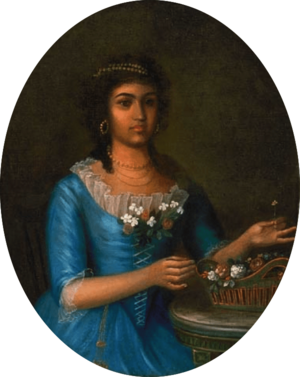Marianne Celeste Dragon facts for kids
Quick facts for kids
Marianne Celeste Dragon
|
|
|---|---|

Marianne Celeste Dragon, 1795
|
|
| Born | 1 March 1777 New Orleans
|
| Died | 22 April 1856 (aged 78) New Orleans
|
| Nationality | American |
| Occupation | Entrepreneur |
| Spouse(s) | |
| Children | Alexander Dimitry |
| Parent(s) | Michel Dragon |
Marie Celeste Dragon (1777-1856) was an important and wealthy woman from New Orleans. She was known for her portrait painted by José Francisco Xavier de Salazar y Mendoza. Marianne was married to Andrea Dimitry. They were an interracial couple, which was unusual for their time. She became one of the most influential women in the Creole community of New Orleans.
Marianne had a mixed background, with Greek-French and African roots. Her life showed some of the challenges people faced with racial inequality in the Creole community. She has been featured in many articles and books, representing the unique history of Creole New Orleans.
Her son, Alexander Dimitry, was a very accomplished person. He was one of the first people of color to attend Georgetown University. He also became the first person of color to serve as a U.S. Ambassador, representing the country in Costa Rica and Nicaragua.
Contents
Early Life in New Orleans
Marianne Dragon was born on March 1, 1777, in New Orleans, Louisiana. Her father was Michel Dragon, a hero from the American Revolutionary War. He came from Athens, Greece, and arrived in New Orleans in the 1760s.
Marianne's mother was Marie Françoise Chauvin Beaulieu de Montplaisir. Her family had African roots. Records show that Marianne's parents were married, even though it was legally difficult for interracial couples at that time. Her family owned land and businesses.
In 1795, a famous Mexican painter named José Francisco Xavier de Salazar y Mendoza painted a portrait of young Marianne. This painting helps us see what she looked like.
Around this time, Marianne met Andrea Dimitry, a man from Greece. They wanted to get married, but laws at the time made it hard for people of different races to marry. To make their marriage possible, Marianne was listed as white in the marriage records. They were married in 1799 and had ten children together.
Family Life and Achievements
In 1803, New Orleans became part of the United States through the Louisiana Purchase. Marianne's family became American citizens. They were one of the oldest Creole families in New Orleans. The family was proud of their Greek heritage. Andrea was fully Greek, and Marianne was half Greek, so their children were mostly Greek.
Many of Marianne's children married people from other countries. There's a family story that some family members even traveled to Greece in the 1830s to find spouses for the children.
Their first daughter, Euphrosine Dimitry, married Paul Pandely. Paul's mother, Elizabeth English, was said to be related to the English royal House of Stuart. Paul's father was Greek.
Marianne's third child was the author Alexander Dimitry. He married Mary Powell Mills, whose father was the famous architect Robert Mills. Robert Mills designed the Washington Monument in Baltimore.
Alexander Dimitry was a very talented person. He was the first person of color to attend Georgetown University. He also became the first person of color to be a U.S. Ambassador. He could speak eleven languages!
Another son, Nicholas Theodore Dimitry, also attended Georgetown University.
The Dimitry family worked hard to build a strong Greek community in New Orleans. By the 1860s, there was a Greek Orthodox Church and a Greek consulate in the city.
The Pandely Affair
In 1853, Marianne's grandson, George Pandely, ran for a local government position in New Orleans. His political opponent, George Wiltz, tried to use Pandely's African ancestry to hurt his election chances. Pandely took Wiltz to court for slander.
The case was dismissed, but this "Pandely Affair" caused a stir in the family. It even led Marianne's son, Alexander Dimitry, to resign from his job as the state superintendent of schools. He was the first Creole person to hold that important position.
This event showed how challenging racial identity could be in that time, even for prominent families.
Later Life and Legacy
Marianne inherited money from her father. She later had a legal dispute with her husband, Andrea, over how her inheritance was managed. She won a large settlement in court. It was quite unusual for a woman of mixed heritage to win such a case at that time.
Marianne Celeste Dragon passed away on April 22, 1856, in New Orleans, Louisiana. She was buried in St. Louis Cemetery No. 1 with her children and their spouses.
Her portrait has been featured in several books, including Behind Closed Doors Art in the Spanish American Home, 1492-1898 (2013) and Exiles at Home (2009). Marianne Celeste Dragon's life story gives us a look into the rich and complex history of Creole New Orleans.
Images for kids


